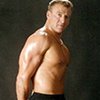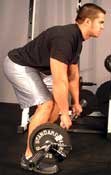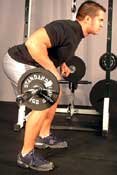It seems like the debates over effective resistance training program design will never end. Throughout my career as a trainer, I have studied and implemented countless strength and hypertrophy regimens. What always intrigued me was that so many of these programs promote what appeared to be completely antagonistic training philosophies!
One guru will insist that only high-volume training is ideal for muscle growth, while another expert declares that low-volume, high-intensity training is the key. Other routines were so convoluted that you would spend more time contemplating the complex variations therein than actually training! This is called "analysis paralysis."
What became apparent, however, was that despite all of the conflicting information, the most effective programs typically share common elements and principles. Rather than focusing on the different theories, it will serve you better to look at the big picture: the fundamentals.
What Really Works
The intention of this article is to present the most effective training principles in a simple and clear fashion. If you design your next program based on these basic concepts, you will get results. When it comes to training for size and strength, this is What Really Works:
1. Use Progressive Overload
This is the most basic and one of the most important principles. Muscles grow bigger and stronger as they adapt to stress. Therefore, you need to progressively overload your muscles each week either by lifting moderately more weight, exerting more force, or performing more repetitions with the same weight. This is why it is so important to record your progress and write down your training goals.
2. Use Compound, Multi-Joint, Free Weight Exercises
Basic, big pushing and pulling movements such as variations of the deadlift, squat, lunge, power clean, overhead press, chest press, row and pull-ups involve more muscles, larger muscle groups, more resistance and greater Neuro-Muscular Activation (NMA) than isolation movements.
Generally, the more of your body you involve in the exercise and move through space, the greater the NMA. By this reasoning, a heavy weighted dip would be more productive than a heavy decline press, and pull-ups are superior to pull downs, for example.
These exercises not only produce greater increases in size and strength in a shorter period of time, but they also stimulate the production of higher levels of growth hormone in your body. In addition, by training destabilized (free weights vs. machines) you are involving more of your small intrinsic muscles.
3. Use Ground-Based Exercises
This idea ties in with the above principle. When possible, choose to train in a standing or ground-based position rather than seated or lying. This alone will make the exercise much more functional, and more challenging!
Compare the seated overhead press to a standing military press; or seated rows to bent-over barbell rows. There is also typically a greater involvement of your core muscles with ground based exercises.
4. Train Your Core
Some define their "core" as only their abdominals; I look at the "core" musculature as your entire midsection, including your abs (rectus abs, tranverse abs, obliques), spinal erector muscles (quadratus lumborum, longissimus, spinalis, multifidus, iliocostalis), and glutes.
Considering this, you should incorporate exercises to target each of these main areas. I recommend starting your workout with some core isometrics, to activate these muscles in order to facilitate a stronger workout and prevent injury.
The basics are the plank, the side plank, the bridge, and the lying back extension. Then I finish each workout with a different isotonic core exercise.
Of course, if you are using the exercises I suggested above, your core muscles are being challenged during the rest of your workout as well. By using functional, free weight, ground-based, compound movements, you are involving your entire midsection to a huge extent.
I also strongly advise against using any belts, wraps or straps during your regular training, as this can decrease the involvement of the important core stabilizers. These training accessories should be reserved for maximum lift attempts and competition, unless otherwise indicated for specific injuries.
5. Train With Balance
I have written entire articles on the topic of 'balance'—balancing rest and training; training different energy systems in balance; having balance in your life. It is an important subject, not to be overlooked. For now, let's look at the following aspects of balance:
Include Stability Training & Unilateral (Single Leg, Arm) Movements:
Incorporate some exercises that force you to balance on one leg or stabilize a weight with one arm, such as step ups, lunges, single arm press, etc.
Working with odd objects such as kegs or sandbags also create a greater demand on your stabilizers and place a new stress on your body, leading to new results. These types of movements will increase the strength of your weaker side and develop your proprioceptive ability.
 |
||
 |
What Does Proprioceptive Mean? Relating to perception of movement and other sensations within one's own body. |
 |
 |
||
Balance The Volume Of Training For (And The Strength Of) Agonist & Antagonist (Opposing) Muscle Groups:
This is an important principle for increasing strength, size, NMA, and preventing injuries. Basically, you want to balance the workload on both your pushing and pulling movements. The force and speed you can generate in a press or a throw is largely affected by the ability of the antagonist muscles to eccentrically stabilize the joint. If you cannot control deceleration, you can't accelerate to your full potential.
Research has also demonstrated that one can recuperate faster by performing a set for an antagonist muscle group between sets. This is known as Push-Pull Supersets, such as super-setting rows and chest presses, or pull-ups and overhead presses. It has been shown to maintain strength between sets, as well as stimulate hypertrophy.
 |
||
 |
What Are Supersets? A superset is the alternating back and forth between two (or more) exercises until the prescribed number of sets is complete, usually with no rest between exercises. There are various types of supersets, however. Find more definitions in our glossary. |
 |
 |
||
 |
||
 |
What Is Hypertrophy? Hypertrophy refers to an increase in muscle size, due to the enlargement of the size of the cells, as opposed to an increase in the number of cells (by cell division, a.k.a. Hyperplasia). Hypertrophy is most commonly seen in muscle that has been actively stimulated, the most well-known method being exercise. |
 |
 |
||
Work On Your Muscular Imbalances:
Muscle tension and joint pain is often due to compensation for joint instability or weakness in another muscle. This is where isolation exercises come into play. You need to train your weak links in isolation before you can incorporate them into a movement pattern. Otherwise, your dominant muscles will continue to compensate, leading to further muscular imbalances.
Prime examples of common weak links are the posterior deltoids, external rotator cuff, lower trapezius, glute medius, vastus medialus, and often some core muscles.
Having said that, it is my opinion that in most cases it is a waste of time to perform an entire workout using only isolation exercises for small muscle groups (unless you are in a prehab/rehabilitation program).
For example, a one hour workout just for "arms" is completely impractical. Each workout should stimulate a majority of target muscle groups with fewer exercises. Think of training movements, not muscles.
Activation Techniques
6. Incorporate Strongman Implement Training
Strongman training and odd object lifting is great for improving a trainee's General Physical Preparedness and stimulating new neural muscular recruitment patterns.
Exercises such as sled dragging, farmers walk, keg pressing, thick bar lifts and sandbag carries increase the use of muscles that may not be challenged with a barbell alone. There is also a huge stimulus placed on your 'core' musculature and your smaller joint stabilizers with this type of training.
In fact, strongman training ties in directly with most of the principles listed above (#2,3,4 & 5)! It involves compound, functional, ground-based movements that strengthen your core and build balance. Strongman training is a fun and effective way to make your workout more productive, and is easy to incorporate into your regular training program. Give it a shot!
7. Incorporate Speed & Explosiveness Training
To maximize your strength potential you need to develop more 'powerful' muscles as well. In order to generate more power you will need to incorporate speed training into your program, in addition to pure strength training. (Remember: Power = Force × Speed).
Activities such as plyometric drills, sprint training, sled dragging, and Olympic Weightlifting type exercises are very effective. This also helps to prepare your body for the unexpected dynamic stresses that can occur in daily life. A great strength coach once said, "Life Is Ballistic. Train For It!"
8. Use A Method Of Periodization
For long term progress, you will benefit from following some method of program periodization. A very general definition of periodization is that it is a training scheme with planned phases of varied intensity, volume, speed, and exercise selection, etc.
The popular Western method is known as linear periodization, which divides the different aspects of strength training into separate phases over time, but it has many limitations.
Conjugated periodization is a very effective method with shorter phases, wherein you train many aspects of strength (such as max strength and dynamic strength) during the same weekly program. This is the method used by Louie Simmons at Westside Barbell Club.
There are other variations (such as pendulum training), but I will not embark on a lengthy explanation at this point. However, I do encourage you to study periodization and adopt a method that makes sense to you.
9. Variation
Most people understand that training load should be progressively increased, but few seem to understand that the training stimulus must also be progressively and periodically varied to continually stimulate your body and nervous system to adapt.
If you keep doing the same workouts with the same exercises in the same order, with the same set and rep scheme, your body will get used to it and your progress will diminish. Therefore you must regularly change things up to stimulate your body to adapt to the new stress by growing bigger and stronger.
Incorporate different rep ranges (i.e., lower reps for max strength or speed training, moderate rep range for hypertrophy, and higher reps for endurance) and change your primary exercises at least every 3-6 weeks. A properly designed periodization program, such as the Westside method, will accommodate for this.
10. Get Enough Rest
Muscles grow while at rest, not while you are training. The resistance exercise is the stimulus for growth, but your sleep, rest and nutrition facilitates the hypertrophy to take place.
In general, most active people need at least 6 to 8 hours of quality sleep each night, dependant on their diet, training intensity, daily activity level, stress, etc. Note that I emphasized "quality sleep"; more than 8 hours may in fact be necessary for adequate recovery.
As far as rest during the workout is concerned, you will need more rest between sets for heavy, maximum effort lifting (i.e., 2 to 4 minutes), and less rest between sets for lighter speed or endurance work (i.e., 60 to 90 seconds). In general, the more intense the set, the more rest is needed between sets. If you don't rest long enough your lactic acid levels can interfere with your performance on the next set.
Also, more is not better when it comes to the duration of your workout. If you can keep your resistance training session between 30 and 90 minutes, you can take advantage of a natural boost to your growth hormone levels at the end of your workout. This can greatly enhance recovery.
However, training for too long can cause a drop in your natural anabolic levels and interfere with your recovery, leaving you feeling drained and weak.
11. Follow A Healthy, Intelligent Nutrition Plan
In order to achieve optimal results, you need to provide your body with high quality 'building materials' and fuel. Here are some very basic nutritional guidelines:
- Consume about 1 gram of protein for each pound of lean bodyweight per day.
- Eat 4 to 6 smaller meals per day.
- Choose less starchy foods, with a lower glycemic index.
- Drink at least 1 liter of water for every 50 pounds of bodyweight per day.
- Eat a balance of nutritious foods, including fruits and vegetables.
- Focus on "whole foods", but recognize that often nutritional supplements are recommended.
- Eat soon after exercising.
- Don't eat a heavy meal right before going to sleep.
- Reduce consumption of simple sugars, caffeine, alcohol, and saturated fats.
Make sense? Good.
12. Flexibility
It is important to maintain healthy range of motion (ROM) around your joints, but most people aren't familiar with active or dynamic stretching and don't use effort to control the extreme stretch positions. Unfortunately, passive stretching (using force to push or pull further into the stretch) is still the most frequently used; although there is growing evidence to question it's effectiveness or safety.
As I mentioned before, muscle tightness is usually secondary to muscle weakness. By strengthening the weak links you will also increase your flexibility. By contrast, if you force a passive stretch (without engaging the muscles involved) you could decrease joint stability even further, increasing the risk of injury. Even though there is research demonstrating the limited benefit to passive stretching, many old school coaches and trainers still argue in favor of its use.
My advice on What Really Works for improving flexibility is to begin your workout with a dynamic warm-up, including dynamic "stretches" such as high knees, butt kicks, walking lunges, bodyweight squats, and arm circles, and then finish your workout with active range of motion stretches, engaging your muscles to actively hold the stretch positions.
At the very least, do not use passive stretching before working out! These stretches dampen the nervous system and relax the muscles, decreasing your ability to safely move weight.
Conclusion
I hope you will find this information helpful in designing a very effective size and strength training program. Keep in mind that I have provided you with only a brief overview of these training principles and I encourage you to research these ideas further. I will also be elaborating on these topics in my future articles.
If you are not familiar with some of the information I have presented, don't be afraid to try something new. Remember, "If you always do what you've always done, you will always get what you've always got." Futility is doing the same thing over and over but expecting different results. Have an open mind. Keep your mind on your goals and keep the faith that you will achieve them!



